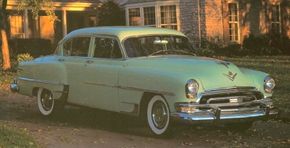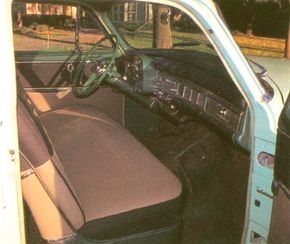During the first half of the 1950s, the 1951-1954 Chrysler New Yorker was either the most popular (1953-1954) model in the line or a close second (1951-1952) to the ubiquitous, lower priced Chrysler Windsor.
Advertisement
Its popularity had certainly as much to do with its engineering as its styling, maybe more so considering its boxy lines. At the heart of that engineering was the new Chrysler 331 V-8 with hemispherical-head combustion chambers: the fabled "Hemi."
The purpose of the hemi heads on the 1951-1954 Chrysler New Yorker was to achieve exceptional volumetric efficiency and truly outstanding performance, while relying on a lower compression ratio that could allow the use of lower-octane fuels than comparably sized non-hemis -- or, conversely, producing a lot more power than comparably sized non-hemis of the same or even higher compression.
This the hemi proved, in competition as wide-ranging as the Mexican Road Race and at National Hot Rod Association dragstrips, Le Mans, and the stock car oval tracks. It was expensive to build, and Chrysler several times abandoned it. In the early 1950s, though, the hemi reigned supreme among V-8s.
Also new in 1951 for the Chrysler New Yorker were two further permutations of Chrysler's old Fluid Drive: Fluid-Matic (standard on New Yorker) and Fluid-Torque ($167 option). Fluid-Matic was simply the original, fluid-coupling four-speed Fluid Drive; Fluid-Torque adopted a torque converter mounted ahead of the clutch. The clutch pedal was used to select high or low shift ranges; within the ranges you "shifted" by lifting your foot from the accelerator pedal.
The 1949-1952 "new" Chrysler products were boxy and practical -- but not svelte. And although much was done to improve them in 1953, their looks cost Chrysler a lot of sales. In 1954, Buick, Oldsmobile, and Pontiac all rushed past Plymouth in the production race, while Chrysler output skidded from 170,000 units to barely 100,000.
Later on, Chrysler would ask the man-in-the-street, "What do you think about when you think about Chrysler?" The answers the pollsters bothered to record almost always were, "Engineering." As far as the public was concerned, that was all Chrysler had going for it in this period.
Relatively few buyers realized that the 1951-1954 Chrysler New Yorker was also beautifully built, almost impervious to rust, and would last a couple hundred thousand miles with minimal maintenance. But these qualities did not seem very important until the 1960s (by which time Chrysler had lost them).
Keep reading to learn more about the 1951-1954 Chrysler New Yorker, including how Chrysler capitalized on the New Yorker's success.
For more information on cars, see:
- Classic Cars
- Muscle Cars
- Sports Cars
- Consumer Guide New Car Search
- Consumer Guide Used Car Search
Advertisement

